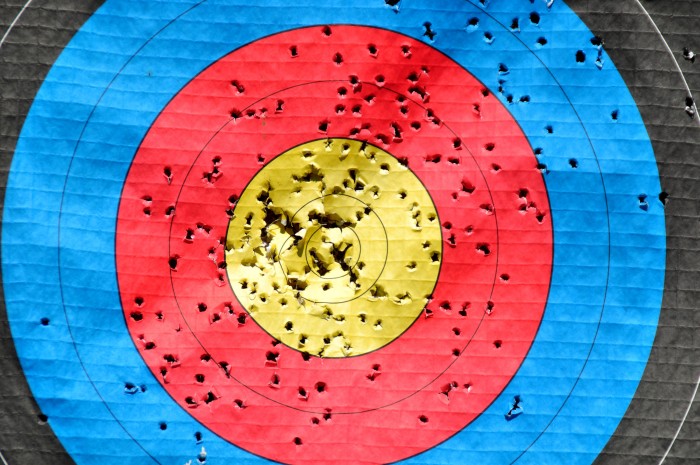There are many different crossbows on the market, so today we’re going to be looking at a few of the very best, and comparing them to see what is the right choice for you.
Recurve Crossbows
First off is recurve crossbows. These crossbows operate much like traditional bows that have been turned sideways and mounted on a stock. The power of the bow comes from the tension housed within the recurve limbs that are drawn back with the string, and which are then released when the trigger is pulled.
Recurve crossbows have been used for centuries, and the advantage of them is that because the design is so simple, they are very easy to maintain and are unlikely to go wrong. Let’s have a look at some examples.
The Jaguar from EK is the ideal starter crossbow. With a draw weight of 150lbs, the crossbow is easy to draw, but will still produce velocities well in excess of 200fps. This means the bolt will fly nice and straight and be accurate enough for target shooting at around 60 yards. The maximum range is obviously much greater – 100 yards plus – but at 60 you should be able to hit a bullseye pretty consistently.
The crossbow is made from a mixture of aluminium and polymer, which keeps the crossbow light, but doesn’t sacrifice any strength. This makes the bow not only easy to transport and carry, but  also eliminates fatigue whilst aiming, allowing you to stay more accurate for longer. The only complaint I have about the stock is that the butt is entirely polymer, with no rubber butt pad. This may increase strength, but it makes the crossbow a little uncomfortable to get into the right position.
also eliminates fatigue whilst aiming, allowing you to stay more accurate for longer. The only complaint I have about the stock is that the butt is entirely polymer, with no rubber butt pad. This may increase strength, but it makes the crossbow a little uncomfortable to get into the right position.
The bow is equipped with basic iron sights and also sports a rail for red dots, scopes or other optics. It would have been nice for another rail somewhere that could hold a torch, but for the price I really can’t complain. This crossbow is available at £58.99 which is frankly a bargain; it will shoot twice as far as any sub 12ft/lb airgun, and is accurate to a tee.
Honestly, this crossbow is fantastic for the price; it’s just hampered by a lack of options and a slightly uncomfortable design. If, however, you can look past these niggles, you’ll end up with a very effective, if a little basic, target crossbow.
At almost four times the price of the EK, the Barnet had better be good to justify itself. Luckily, the crossbow is extremely well made and the build quality is apparent as soon as you pick it up. The crossbow feels both light and strong and is exceptionally balanced, making you want to draw it up to your shoulder almost instinctively.
 The crossbow has a draw weight of 150lbs and also 65ft/lbs of muzzle energy. This makes the bow both easy to draw and also powerful enough to provide good range. The crossbow has a fantastically responsive, moulded metal trigger that houses a predictable let off that helps prevent you from “pulling” your shot.
The crossbow has a draw weight of 150lbs and also 65ft/lbs of muzzle energy. This makes the bow both easy to draw and also powerful enough to provide good range. The crossbow has a fantastically responsive, moulded metal trigger that houses a predictable let off that helps prevent you from “pulling” your shot.
In addition to the crossbow, the Recruit comes with a lightweight bolt quiver, three bolts, lube wax and even a red dot sight. There are much better quality sights available, such as the models by Hawke or Meopta, but to have one included with the bow is a nice touch. The bolts included with the bow are also not of particularly high quality, and, to be honest, the accessories included would be something I’d replace if I was using this crossbow day in day out.
The bow is also equipped with an anti-dry-fire system to prevent the most common way of bow breakages, and this makes the bow feel very reliable. The crossbow is able to achieve around 2” groups at 50 yards, pretty impressive, and I’m sure with a little training you could maybe get this up to 70 plus.
The Recruit is a good bow and definitely a step up in quality from the Jaguar, I don’t think it’s four times better though, especially when it comes to accuracy and power, which are almost identical.
Compound Crossbows
Compound bows use twin cams at the end of each limb to a) increase the bow’s power and b) to prevent tension being stored in the string when the bow is drawn, which minimises the risk of dry fire and breakages. Compound bows tend to be more expensive than recurves and take more maintenance.
The Blade, from EK Archery, is their entry level model in the compound bow market, and is ideal for those looking for maximum power from a minimum price. The Bow comes with all the accessories you need to get started: 4×32 crossbow scope, cocking rope, 3-bolt quiver, 3 x 20″ aluminium bolts, and string wax, consequently making this crossbow a perfect choice for beginners.
I would advise against younger shooters using this bow, however, as even with the cocking rope provided, the Blade takes a fair effort to cock. Not too hard to be impossible, but one of those ones where everyone says they find it really easy, but you can see their face going a bit red and a few beads of sweat forming after each shot. No one likes to admit defeat, I guess. Now in and of itself, this is not much of a problem, but in younger hands I could see this leading to a dry fire if the rope isn’t cocked fully.
The blade has an extendable, M4-style stock that makes it suitable for people of all shapes and sizes, and the level of comfort has been greatly improved over the Jaguar with a moulded shape that fits neatly into the shoulder. The crossbow also shoots incredibly well. I’m impressed with EK’s ability to produce great performance from such inexpensive bows. The Blade is responsive and manoeuvrable in the hands, and will deliver tight and effective groupings at ranges of up to 60 yards.
A great starter crossbow that includes everything needed for a beginner to get into their shooting hobby.
The Edge is a serious piece of kit. One of the first things I noticed was how easy it was to cock. With a draw weight of only 135lbs and the bow’s cam’s greatly reducing tension on the string, the  Edge is quick and easy to load up. Even after 20 or so shots, the Edge was nowhere near as hard on my arms as the Blade, and this will keep your aim straighter for longer.
Edge is quick and easy to load up. Even after 20 or so shots, the Edge was nowhere near as hard on my arms as the Blade, and this will keep your aim straighter for longer.
This doesn’t mean that the crossbow is lacking power, however, and the Edge will produce a whopping 110+ ft/lbs of muzzle energy. Yeah, quite a bit more than I expected, to be honest. This makes the Edge absolutely in a league of its own when it comes to range, and the added power also helps keep the bolt straight in flight, adding to the crossbow’s accuracy. I have heard reports of the riser being slightly off centre with some crossbows, which makes them difficult to sight in, but my model was absolutely fine. I seem to have pretty good luck when it comes to these things.
The crossbow comes equipped with a variety of safety features, such as an automatic safety and an anti-dry-fire mechanism, and the crossbow also has all the usual accessories. The scope, in particular, is fantastic; it’s 4×32 with excellent clarity and coated lenses to help maximise light transfer in low light. It is certainly a step up from the plain tubes included with less expensive models.
Speaking of expense, the Edge is the most expensive crossbow I’ve tested here – by some margin as well – and I’m not really sure what it does to justify its price tag. It’s nice to shoot, sure; it’s easy to cock; and it’s very accurate. But actually, so is the EK, which is a fraction of the price. The build quality is good, but not exceptional, and although I was impressed shooting the bow, I would think long and hard before buying one for that amount of money.
Pistol Bows
These are like regular bows that instead of needing to be shouldered can be fired from a pistol grip. These bows are typically less powerful, though still more powerful than an airgun, and also smaller than a regular crossbow. The majority of these will feature recurved limbs, although there are a few compound pistol crossbows sneaking onto the market.
The EK Cobra is perhaps the most popular pistol bow we sell, and the reason for this is clear: the whole bow costs just £17.99, including bolts.
 The pistol bow is incredibly easy to cock, and features an ingenious system that pulls back the string by pressing a button and moving the stock back, which pulls two metal hooks backwards, cocking the crossbow. This system is great, as it’s easy to use and eliminates the need for fiddling around with the bow’s small strings; and it also prevents dry fire. In fact, it’s such a good system, I can see it spreading to other pistol bows if EK haven’t patented it.
The pistol bow is incredibly easy to cock, and features an ingenious system that pulls back the string by pressing a button and moving the stock back, which pulls two metal hooks backwards, cocking the crossbow. This system is great, as it’s easy to use and eliminates the need for fiddling around with the bow’s small strings; and it also prevents dry fire. In fact, it’s such a good system, I can see it spreading to other pistol bows if EK haven’t patented it.
The Cobra has a draw weight of 80lb and shoots exceptionally well for its size. The bow is equipped with iron sights that are adjustable, but there’s no rail for external optics. The bow is also equipped with safety, which must be pushed forward to fire, and the trigger of the bow is machined metal for added durability.
All in all, this pistol bow is very well equipped, and I can’t get over how cheap it is. At under £18, this crossbow is cheaper than half a tank of petrol or a meal out with the missus, and will be infinitely more fun than either of these. Honestly, this pistol bow is great, and, for the price, is one of the most fun items we sell.
Hopefully this has given you a few options to consider. Personally, I like the Cobra as it is still pretty powerful for a pistol and it is just so cheap!
Steph

